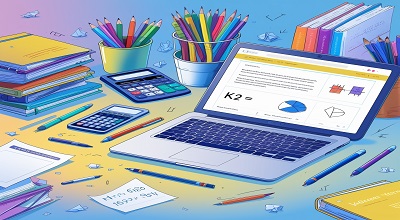K-12 Learning Tools
The education sector has undergone a massive transformation with the integration of technology in K-12 learning. Digital learning tools enhance engagement, personalize education, and streamline classroom management. From interactive whiteboards to AI-driven adaptive learning platforms, these tools are revolutionizing how students learn and teachers instruct.
This article explores the latest K12 learning tools, their benefits, examples, and future trends to help educators and institutions make informed decisions.
Benefits of K-12 Learning Tools
Modern K12 learning tools offer numerous advantages:
- Personalized Learning: Adapts to individual student needs.
- Engagement & Motivation: Gamification and interactive content make learning fun.
- Accessibility: Supports remote and hybrid learning.
- Efficiency: Automates grading, attendance, and feedback.
- Collaboration: Encourages teamwork through digital platforms.
- Data-Driven Insights: Helps teachers track student progress effectively.
Types of K-12 Learning Tools
Digital Learning Platforms
These platforms provide a centralized hub for lessons, assignments, and assessments.
Example: Google Classroom, Schoology
Interactive Whiteboards
Digital boards that enhance visual and interactive learning.
Example: SMART Board, Promethean ActivPanel
Gamification Tools
Integrates game elements to boost engagement.
Example: Kahoot!, Classcraft
Adaptive Learning Software
AI-powered tools that adjust content based on student performance.
Example: DreamBox, IXL Learning
Collaboration Tools
Facilitates group projects and discussions.
Example: Microsoft Teams, Padlet
Augmented & Virtual Reality (AR/VR)
Immersive learning experiences.
Example: Nearpod VR, Google Expeditions
Latest K-12 Learning Tools with Examples
Google Classroom
A free, cloud-based platform for assignment distribution, grading, and communication.
Khan Academy
Offers free courses in math, science, and humanities with interactive exercises.
Nearpod
Interactive lessons with VR field trips and real-time assessments.
Quizizz
Gamified quizzes with memes and leaderboards to engage students.
Prodigy Math
A game-based math learning platform for grades 1-8.
Flip (Formerly Flipgrid)
A video discussion tool where students share responses via short clips.
Seesaw
A student portfolio tool that encourages creativity and reflection.
Edpuzzle
Allows teachers to embed quizzes into videos for interactive learning.
Minecraft: Education Edition
Teaches coding, collaboration, and problem-solving through gameplay.
Canva for Education
A design tool for creating presentations, infographics, and posters.
How to Choose the Right K-12 Learning Tool?
- Align with Curriculum: Ensure the tool supports learning objectives.
- Ease of Use: Should be intuitive for teachers and students.
- Cost & Accessibility: Free vs. premium features.
- Integration: Works with existing LMS (e.g., Google, Microsoft).
- Security & Privacy: Complies with data protection laws (FERPA, COPPA).
Challenges in Implementing K-12 Learning Tools
- Budget Constraints: High costs of premium tools.
- Teacher Training: Requires professional development.
- Tech Infrastructure: Schools need reliable internet and devices.
- Student Distraction: Overuse of gamification may reduce focus.
Future Trends in K-12 Learning Tools
- AI & Machine Learning: Smarter adaptive learning.
- Blockchain for Credentials: Secure digital certificates.
- More AR/VR Integration: Enhanced immersive learning.
- Voice-Activated Assistants: AI tutors like Alexa for Education.
Conclusion
K-12 learning tools are essential for modern education, offering interactive, personalized, and efficient learning experiences. By selecting the right tools, schools can enhance student engagement and academic success.
FAQs
Q1: What are the best free K-12 learning tools?
A: Google Classroom, Khan Academy, Quizizz, and Canva for Education offer free versions.
Q2: How does gamification improve learning?
A: It increases motivation through rewards, competition, and interactive challenges.
Q3: Are VR tools effective in K-12 education?
A: Yes, VR enhances engagement and provides immersive learning experiences (e.g., virtual labs).
Q4: How can schools ensure data privacy with digital tools?
A: Choose tools compliant with FERPA and COPPA, and review privacy policies.
Q5: What is the future of AI in K-12 education?
A: AI will enable personalized learning paths, automated grading, and intelligent tutoring systems.
Free Download Link: JudiKing888 APK
